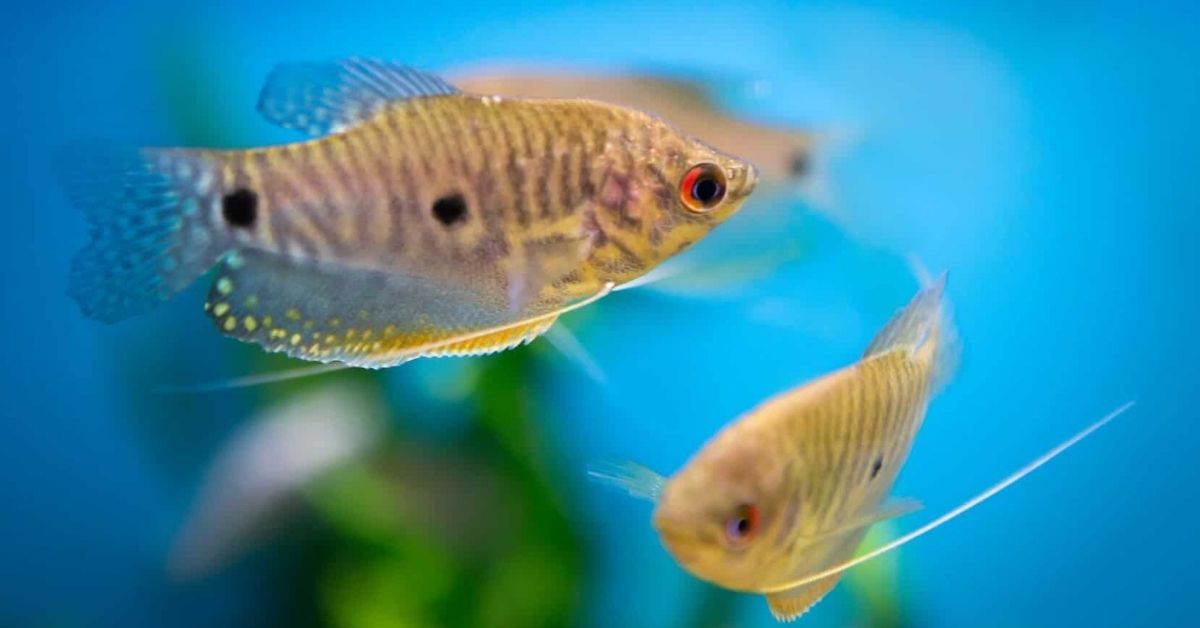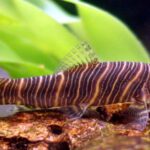Across a wide variety of artists and genres, talented fish around the globe vied for this year’s awards.
Amongst the snakeskins, kisses, chocolates, and intense competition a few stood out among the 133 contestants found throughout South-East Asia hoping for the coveted title.
After much deliberation the results are in, so the envelope please…
This year’s top ten ‘gourami fish’ award winners as chosen by both the academy and people’s choice alike are…
10 Types of Gourami Fish
1. Dwarf Gourami (Richogaster lalius)
Although these are in no particular order other than being stunning members of the gourami family, let us start with one of the tiniest of talents. They are amongst the easiest to care for and require little tank maintenance.

Topping out at just over four inches, the dwarf gourami is a brightly-colored show-stopper. They are bejeweled in royal purple or blue iridescence speckled with green or blue-spotted gems on the rear.
The only thing getting used to maintaining this top model is their diet of (often) live foods. Although they aren’t finicky and will eat just about anything as opportunistic omnivores they do want to hunt. It’s more about instinctual behaviors than purely being an aggressive fish.
They rarely strike out except in self-defense. They might be dwarf in name but are also capable of boxing outside their weight class in every fight.
Size: 4 inches
Difficulty: Beginner
Minimum Tank Size: 55 gallons (per dozen)
Lifespan: 7 years
2. Giant Gourami (Osphronemus goramy)
In the heavyweight class, we have the giant gourami. It straddles a range between Indonesia, China, India, and Vietnam.

Its natural range is only half of that, but they have been accidentally and purposely let loose across the region. Now they can be found throughout all of South-East Asia and its many Indian Ocean islands.
Despite their storied past and unusual recent dating patterns, the Giant gourami is a favorite fish for any collection. Care is just as easy as their smaller cousins but due to size differential, it is inadvisable to put sizeably smaller fish in their tank; they will be eaten.
And for the grand finale, the Giant gourami has one last trick. It can identify individual objects and people and will actively seek out engagement at the surface. While petting a fish seems odd, they tolerate it in captivity and seem to encourage socialization.
Size: 20 inches
Difficulty: Intermediate
Minimum Tank Size: 200 gallon (at maturity)
Lifespan: 7 years
3. Sunset Gourami (Trichogaster chuna)
On the Sunset strip, the Honey gourami can perform for up to eight years straight. Lady performers try and hide their stunning looks decked out in simple silver gowns while the gentlemen don’t even make an attempt at modesty.
They’ll be found out in the front chorus flashing their black and gold tuxedos.
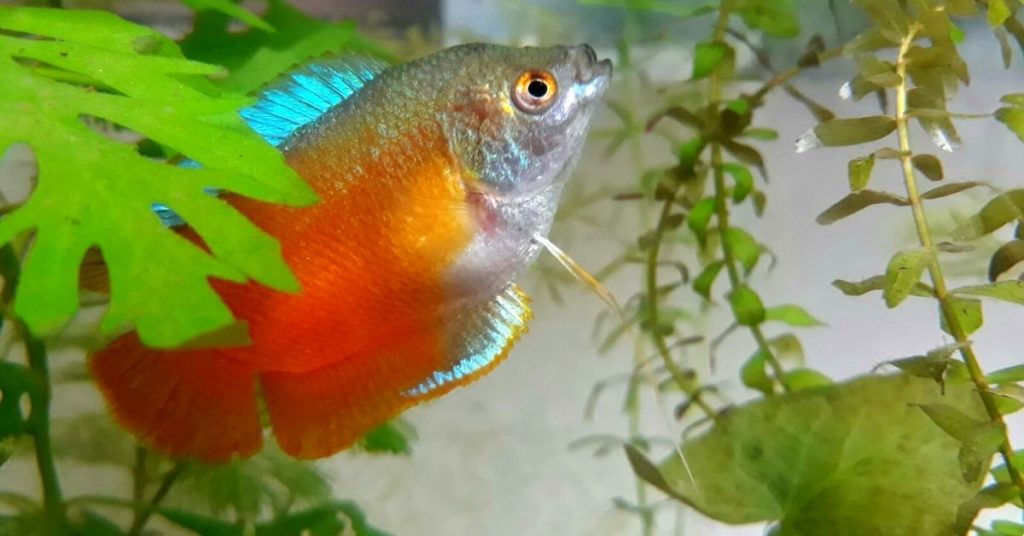
All jesting aside they are sleek, classy-looking fish, however, their sexual dimorphism (like birds) does give preferential coloration to the males. However, they compete on equal footing when it comes to unusual hunting techniques.
Both sexes double as highly effective archers. They will squirt water at prey including insects perched on swampy vegetation above the surface. For these performance skills and a great costume, they deserve a nomination.
Size: 3 inches
Difficulty: Beginner
Minimum Tank Size: 55 gallons (per dozen)
Lifespan: 8 years
4. Blue Gourami (Trichopodus trichopterus)
This artist, formerly known as the Three Spot Gourami (formerly known as the Siamese Gourami or Opaline Gourami) is always a serious contender. Its main superpower is the ability to breathe oxygen through the air as well as through its gills.
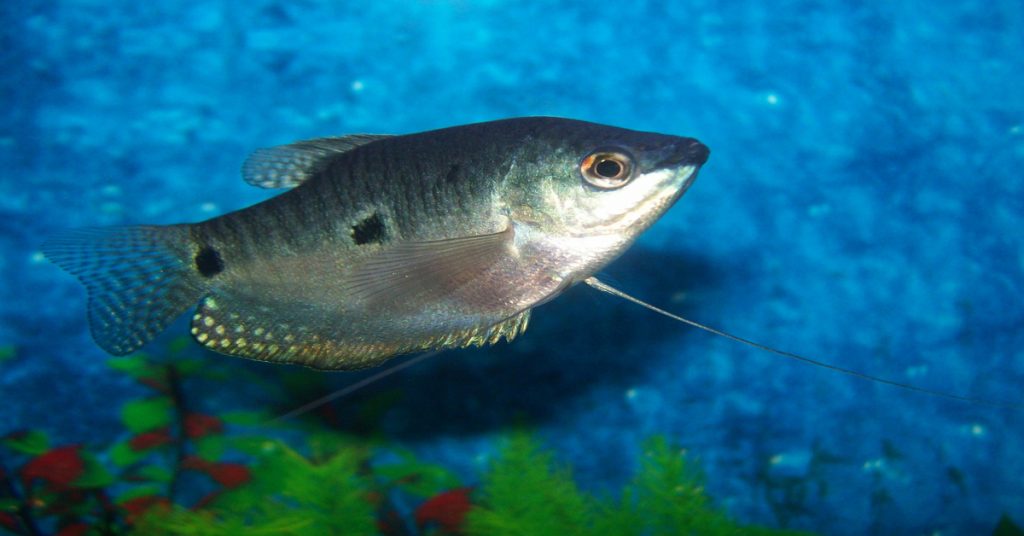
Although all members of the family Osphronemidae can do this to some degree the blue gourami is particularly adept as visits the surface often. They do so not only to breathe but also to seek out prey above or at the surface.
Although they aren’t picky omnivores they do have some diva-like demands. Their dressing room and stage need to be outfitted with torrents of vegetation. They choose to live in such shallows at home and expect to be treated likewise while on the road.
So if you’re considering a Blue gourami specifically, please be sure to spend time getting their habitat as close to what they would find in nature. They thrive hunting in the tall grasses and nibbling away almost randomly at every kind of vegetation. So give them the recognition they deserve.
Size: 6 inches
Difficulty: Intermediate
Minimum Tank Size: 20 gallons
Lifespan: 8 years
5. Chocolate Gourami (Labeo cyclorhynchus)
If you really want to talk about true diva status, the Chocolate gourami might be a top pick. Although they aren’t picky omnivores and get along with other very small fish they choose to live under very specific water conditions.
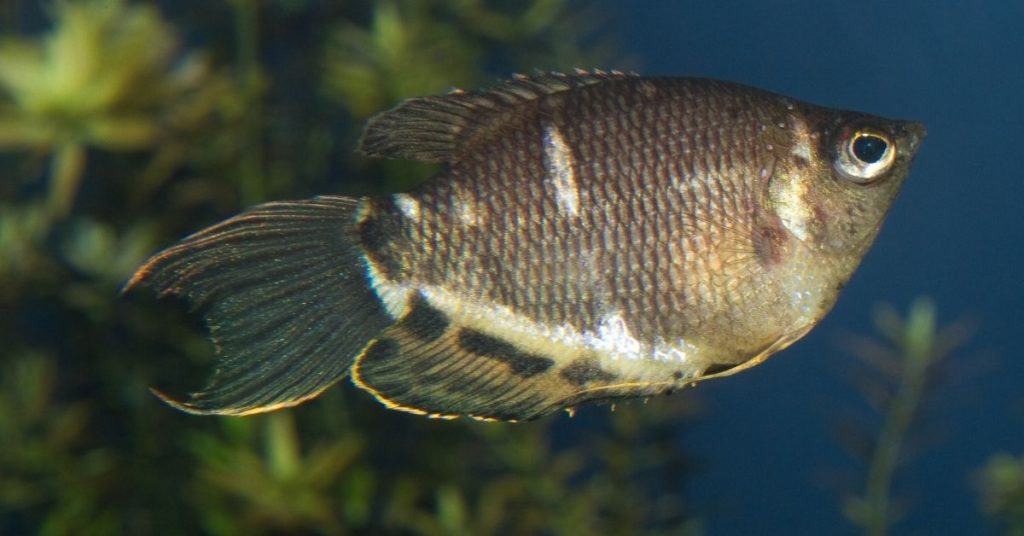
Their native homes are the peat bogs of India. As such they have adapted over time to that specific niche. They need acidic, darkened water that is normally above 81° F / 27.2°C.
Although we like to turn over our tanks and maintain responsible cleanliness, the Chocolate gourami is used to living in a muddy ditch with little circulation but replenished rainwater. To mimic the rains, water should be replaced often, but in very small amounts at regular intervals.
So why put up with such a Prima donna? Well, they are amongst the most beautiful of gouramis despite their uniform color. They’ve perfected the copper-brown look with individually outlined bordered scales. Add in some funky stripes and you’ll have a Chocolate gourami show-stopper of your own.
Unfortunately, they are pretty exclusive. Their only tank mates will be other very small fish who also live in conditions like loaches or tetras.
Size: 2.5 inches
Difficulty: Advanced
Minimum Tank Size: 30 gallons
Lifespan: 8 years
6. Paradise Gourami (Macropodus opercularis)
There’s always one trouble-maker in every lot and the Paradise gourami would be the one trashing the hotel room. That is not to say they’ll tear up your carefully tended tank, just know they can be tough business partners.
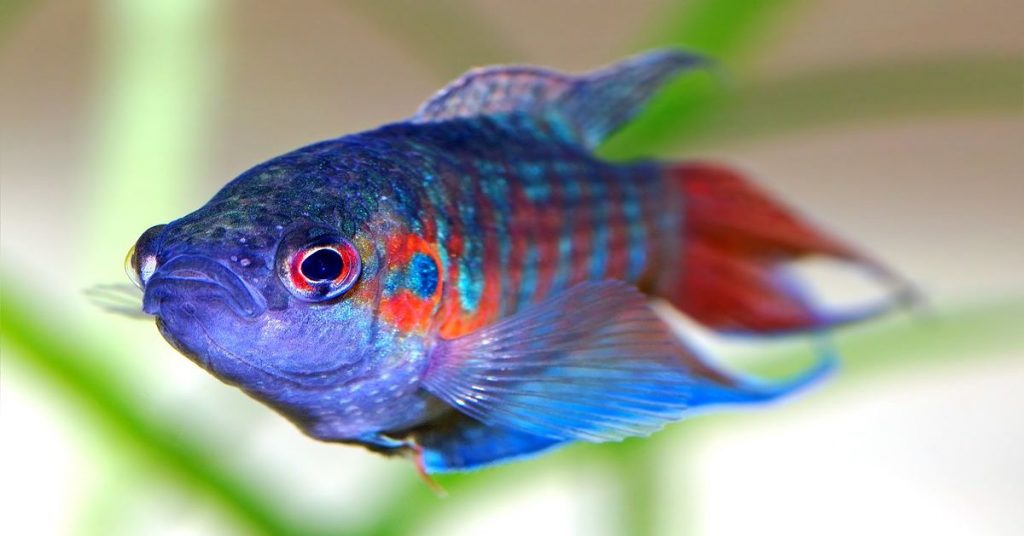
Anything that is smaller than them is a possible snack. Any of their peers (or other tankmates) will be pestered or bullied like kids in a schoolyard. The bully might not get you today, but know they will one day.
All of which to say they don’t play well with others. So, whatever you do, please do not put competing (any two) males together as there will be a throwdown.
Their only suitable companions are very large peaceful (vegetarian) fish that are just way too big to be in the same league as this pint-sized bully. Other than these behavioral issues the Paradise gourami should never be discounted. That and their blue-gold and orange hues certainly aren’t hard on the eyes.
Size: 3 inches
Difficulty: Intermediate
Minimum Tank Size: 20 gallons
Lifespan: 8 years
7. Snakeskin Gourami (Trichopodus pectoralis)
Every star has a key attribute and for better or worse this one is considered one of the tastiest. Although it is a gourami that can hold its own in terms of performance, technical difficulty, and stylistic merit it does happen to be a widely farmed fish in South-East Asia.

Those that might consider them friends, not food, like many aquarists will find them amiable neighbors. They just need some space to roam and grow to their full potential of six inches.
Their spawn will also need some space as they breed prolifically often several thousand in just one go. Sex and fame have always been found on the road to stardom so be sure to invest in tank separators in case things get out of hand at the pad.
Size: 6-10 inches
Difficulty: Intermediate
Minimum Tank Size: 55 gallons
Lifespan: 5 years
8. Sparkling Gourami (Trichopsis pumila)
The Sparkling gourami (aka pygmy gourami) is another small, but shining starlet in the lineup. If any gourami was going to win a sound recording award it might be this one. It has the strange ability to produce audible creaks or clicks when they are happy or mating.

Beyond their ability to belt out ballads of love they too are strikingly attractive small fish. Typically brown-skinned they are adorned with dozens of sequence-like, flashy colored spots. These are further augmented by lengthy fins all-round that are equally bespeckled much like the tail feathers of a peacock.
If anyone is strutting up to the podium tonight, it will be the Sparkling gourami. Unfortunately, they don’t play well with others and can be very choosy about roommates. For this reason alone we are bumping the difficulty level as striking the right balance can prove tricky.
Size: 4 inches
Difficulty: Intermediate
Minimum Tank Size: 30 gallons
Lifespan: 4 years
9. Kissing Gourami (Helostoma temminckii)
If there was an award for acting the Kissing gourami might well sweep the board. They are named because of an odd behavior so far uniquely found in this species.

As a sign of aggression, they are seen to press grinding lips together. It’s not quite an action-sequence duel, but more akin to how many land mammals (in particular) make themselves look big to opponents.
While we might puff out our chest, open our eyes and grunt instinctively in the same way they ‘kiss’. Hence the kissing gourami got its name by the way they wiggle and press their intramandibular joint.
This special talent, like our opposable thumb, allows them to reach places to feed others cannot. Give them the tiniest crevice and they will explore it. Put any barely-visible aquatic invertebrate in from of them and they will capture it.
At lastly if you build them a near-to-native habitat to enjoy, they’ll have some tall grass handy when the paparazzi arrives hoping for that cover story smooch. Plus they actually need both plant and animal food, so this is an absolute must.
Beginners can certainly keep these fish but know they require slightly more advanced levels of upkeep, conditions, setup, and maintenance. With care and guidance, you can count yourself as a graduate to the intermediate class and proud owner of a killer kisser.
Size: 6 inches
Difficulty: Intermediate
Minimum Tank Size: 20 gallons (per individual)
Lifespan: 10 years in the wild, longer in captivity
10. Pearl Gourami (Trichopodus leerii)
And best dressed goes to… the Pearl gourami. Decked out in bronze their entire body is covered with iridescent blue-white spots reminiscent of pearls. This cover model is highly sought after by collectors worldwide solely based on aesthetics.

Although they are flashy even on the dullest days, during the mating season males grow brighter with each passing day. After spawning, this will subside and they will return to normal.
Be wary though of pet stores where these fish are all brilliant, all of the time. Unscrupulous vendors have been known to slip them some estrogen pills to improve their vibrancy. While not common in regulated environments this does sadly occur in the marketplace across numerous species including the Pearl gourami.
Complicating things further are the highly-specific needs it has for breeding. They anchor their eggs amongst the vegetation in clusters woven between the vegetation. As such you will need very good, tightly woven, plant floor coverage to promote reproduction.
In this relationship, the prospective father gathers and guards the nest as the eggs develop into fry. Once they hatch you can improve the survival of the fry by separating them from their parents. This will produce another bounty of ocean pearls for generations to come.
Size: 5 inches
Difficulty: Intermediate
Minimum Tank Size: 30 gallons
Lifespan: 5 years
Final Thoughts
Gouramis are popular amongst aquarists for their general ease of care, versatility, and visual beauty. While some have very specific evolutionary traits and preferences of habitat overall they are quite robust if you have down the basics.
Above all, you are trying as best as possible to mimic the food, shelter, and comfort needs of your gourami guests. Fortunately, when it comes to food most are omnivorous and opportunistic hunters.
When it comes to building a love nest or the perfect singles pad things can get complicated for gouramis. However, with over 130 known species there literally is a commercially available kind for every prospective owner.
Young, old, beginner or trail-guide adventurers alike will find joy, engagement, and beauty among these award-winning fish.
